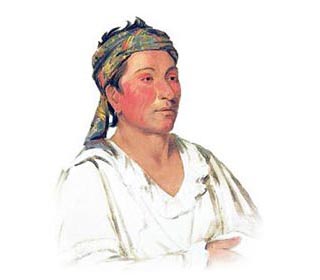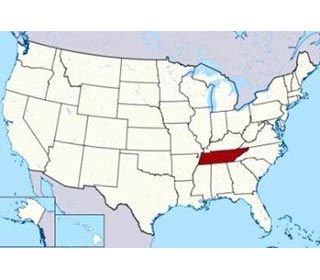What language did the Shawnee tribe speak?
The Shawnee tribe spoke in the Algonquian language. What did the Shawnee tribe eat?
The food that the Shawnee tribe ate depended on the resources that were available to them in the area they lived in - The food of the Shawnee people who inhabited the Great Plains region was predominantly buffalo but also they also hunted deer, elk, bear and wild turkey. Their diet was supplemented with roots and wild fruit and vegetables
The food of the Shawnee Woodland people were fish and small game including squirrel, deer, raccoon, bear and beaver. Corn (maize), pumpkin, squash and beans were also available - The food of the people who inhabited the Southeast included meat from animals such as rabbits, wild hogs, turkeys, eagles, opossums, raccoons and deer. Many farmed crops of corn (maize), beans, dried fruit, pumpkins and nuts
What weapons did the Shawnee use?
The weapons used by the Shawnee tribe included bows and arrows, a variety of different clubs, hatchet axes, spears, lances and knives. The rifle was added to their weapons with the advent of the white settlers. What clothes did the Shawnee tribe wear?
The clothes worn by the Shawnee tribe were dictated by the climate. In warm climates they wore breechcloths in the summer and in cold climates they wore fringed tunics or shirts and leggings. Warm robes or cloaks were also worn to protect against the cold and the rain. The Shawnee tribe also adopted the types of clothes worn by the white settlers and that were available through trade. Shawnee men wore cloth shirts made of cotton or calico, and European style trousers or pants. Their jackets were often in the style of frock coats. Cloth turbans or a type of bandana were a popular form of headwear. Their turbans were made of a woolen shawl, sometimes covered with a piece of calico or even silk. The turbans were occasionally encircled by a band of metal (tin or siver) and adorned by feathers. Who were the most famous leaders and chiefs of the Shawnee tribe?
The most famous leaders and chiefs of the Shawnee tribe included Chief Cornstalk, Tecumseh (1768 – 1813) and Chief Chief Blue Jacket (c1743 - c1810). Shawnee History Timeline: What happened to the Shawnee tribe?
The history of the Shawnee people dates back to the ancient Adena culture. The following history timeline details facts, dates and famous landmarks and battles fought by the Nation. The Shawnee timeline explains what happened to the people of their tribe. Shawnee History Timeline 1000: Woodland Period including the Adena and Hopewell cultures established along rivers in the Northeastern and Midwestern United States which included trade exchange systems 1677: French trader Claude-Charles Le Roy Bacqueville de la Potherie made the first white contact and established good relations with the tribe 1670's: The Shawnee trade extensively with the French 1689: The French and Indian Wars (1689-1763) erupted between France and Great Britain and their respective Indian allies. The Shawnee tribe, led by Chief Cornstalk, sided with the French 1763: Shawnees joined the Ottawa and other tribes in Pontiac's Rebellion against the British 1778: Daniel Boone was captured by the tribe and warned to leave "Kentucky", he managed to escape 1774: The tribe were defeated in Lord Dunmore's War along the Ohio River 1774: The Americans defeated the Shawnee in the Battle of Point Pleasant (October 6, 1774) and Chief Beanstalk was killed. Blue Jacket emerged as a strong Shawnee leader 1775: The American Revolutionary War (1775 - 1783). The Shawnees fought with the British against the American forces 1783: The 1783 Treaty of Paris ended the American Revolutionary War the British abandoned their native allies and ceded the land between the Appalachian Mountains and the Mississippi River to the United States (the Northwest Territory) 1782: The Shawnee joined by the the Western Confederacy of tribes including the Delaware, Wyandot, Miami, Ottawa, Chippewa, and Mingo. Their objective was to keep the Ohio River as a boundary between Indian lands and the United States and to remove settlers from Kentucky and Ohio 1785: The Northwest Indian War (1785–1795) aka as Little Turtle's war erupted 1790: "Harmar's defeat" - General Josiah Harmar was defeated in his attempts to subdue Native Indians in the Northwest Territory 1791: Battle of the Wabash on November 4, 1791. American Indians were led by Little Turtle and Blue Jacket won a major Native Indian victory against Americans led by General Arthur St. Clair. 1794: Battle of Fallen Timbers on August 20, 1794. Major General Anthony Wayne defeated Blue Jacket and the Native Indians 1795: The Treaty of Greenville was signed on August 3, 1795 following the Battle of Fallen Timbers in which the Native Indians were forced to cede much of present-day Ohio to the United States 1795: The Treaty of Greenville was made on August 3, 1795 that ended the Northwest Indian War 1805: The Treaty of Fort Industry was signed on July 4, 1805 in which Blue Jacket and Tecumseh relinquished even more of Ohio 1810: The Death of Blue Jacket. Chief Tecumseh continued the Shawnee fight during Tecumseh's War in a final attempt to reclaim Shawnee lands in the Ohio Country. 1811: Tecumseh's War (1811–1813): The Battle of Tippecanoe (1811), the Battle of Fallen Timbers, the War of 1812 and the Battle of the Thames in which Tecumseh was killed 1815: Shawnee are moved into Arkansas and in 1820 moved to Texas 1830: The Indian Removal Act was passed calling for the relocation of all tribes to “Indian Territory” west of the Mississippi River. 1831: August 8, Treaty at Wapaghkonnetta and Hog creek in Ohio. Land ceded and removed to land west of Missouri 1832: The Treaty of 1832 called for the removal of all Shawnee to the west 1832: Wapakoneta Shawnee leave Ohio and removed west of the Missouri River, into Kansas 1833: Hog Creek Shawnee removed to Kansas 1861-65: supported the Union during the Civil War
1867: Shawnee located on three reservations in Indian Territory. The Absentee Shawnee from Texas settled with the Potawatomi, the Kansas Shawnee moved to the Cherokee reservation. Other tribe members settled in Ottawa County, Oklahoma
The Story of Shawnee
For additional facts and information refer to the legend and the Story of Tecumseh and the Wars with the Western Indians. |


